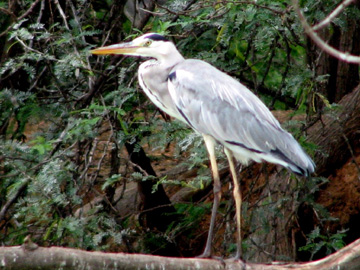Grey Heron.(
Ardea cinerea )
-Ragoo Rao
An ashy grey lanky bird with white crown and neck, underside being greyish, with a long black occipital crest and long flowing feathers on the middle of
the fore neck with black streaks is the graceful Grey heron.
This bird has a very graceful stance found usually with a S curved long neck and a dagger like yellow beak.
The females are also similarly colored but the black markings are less developed.
 One can find these graceful bird, usually solitary, along the lake shores and reeds, usually in the late evenings.
Approach should be very cautious as these birds are very cautious and alert.
Most of the times it is only when these birds off, one would know that there was a grey heron somewhere near the shore.
One can find these graceful bird, usually solitary, along the lake shores and reeds, usually in the late evenings.
Approach should be very cautious as these birds are very cautious and alert.
Most of the times it is only when these birds off, one would know that there was a grey heron somewhere near the shore.
Their distribution is throughout the country except for very high altitudes. They are resident to the vicinity but migrate
only locally to areas with more favourable conditions. A grey heron stalking
fish and small frogs wading in shallow waters is really a sight.
Everything appears to be in slow motion until the bird strikes with its dagger like beak into the water to get the prey.
While the birds are alert, waiting at shore-line of lakes, hardly any movement can be noticed.
They stand still. Late evenings are the best time to watch these birds from a distance and stealthly.
When these birds take off, its another marvel, wing beats are deliberate and in slow motion carrying them gracefully
through the air. A hoarse croak,,,,is uttered when disturbed and the bird is air-borne.
Nesting season is November to March in South India and July to Sept. in the North.
The nest is a twig platform lined in the centre with soft grass and feathers.
The nests are usually built in colonies with other herons on medium sized trees.
3 to 6 deep sea green eggs are laid and both parents share all domestic chores.
A marvelous graceful bird which demands a high amount of stealth to photograph and record all their life habits.